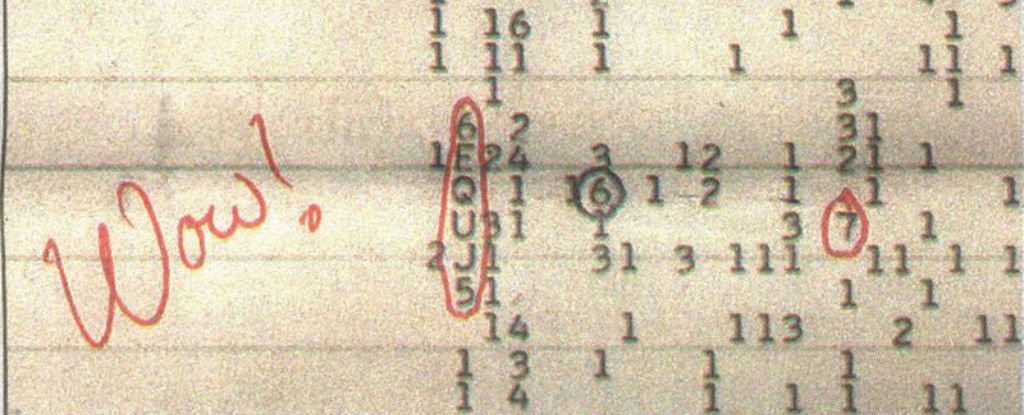A super powerful space laser could be the source of a mysterious signal that has puzzled astronomers for nearly 50 years.
No, not a warning shot from an alien civilization, but rather the work of a hydrogen cloud and a neutron star; the dense core of a massive star after a supernova blew its viscera out into space.
A new hypothesis suggests that under the right circumstances, such an object could produce a signal just like one that surprised astronomer Jerry Ehman on 15 August 1977, prompting him to write the word “Wow!” on the printout.
The research, available as a preprint on arXiv, is undergoing revisions, but the findings so far are based on newly discovered detections of similar signals, suggesting that the team led by astrobiologist Abel Méndez of the University of Puerto Rico at Arecibo is on the right track.
“Our latest observations, made between February and May 2020, have revealed similar narrowband signals near the hydrogen line, though less intense than the original Wow! signal,” Méndez explains.
That original signal was spotted by Ehman in data collected by the Ohio State University’s Big Ear radio telescope. Lasting just 72 seconds in total, it was an extremely powerful flash of radio waves near the 1420 MHz hydrogen line, the wavelength emitted by hydrogen when it changes its spin orientation.
Given hydrogen’s ubiquitous presence throughout the Universe, some scientists have speculated light at this frequency could serve as an easily recognized landmark on the electromagnetic spectrum, one technologically-advanced aliens might elect to use to signal their presence.
If the famous pulse was indeed a ‘hello’ from afar, it contained no modulation that could be decoded. The Wow! signal didn’t move, making it unlikely to be a nearby satellite, and also never repeated in the way we might expect of a deliberate transmission, ruling out repeat observations with improved technology. What’s more, many natural things emit radio waves with a wavelength of 1420 Mhz, so while we can’t conclusively rule aliens out, it doesn’t seem likely.
That leaves us with trying to find a natural explanation for the signal, which is what Méndez and his team have been attempting. Specifically, they looked for brief emissions of narrowband radiowaves similar in frequency to the Wow! signal in archived data from the now-retired Arecibo Observatory‘s Radio Emissions from Red Dwarf Stars (REDS) project.
They found four records worthy of further investigation, spotted coming from the vicinity of a tiny red dwarf named Teegarden’s Star just 12.5 light-years away. Though fainter than the Wow! signal, they were similar enough that they could provide clues about the famous signal’s origin.
According to the team’s analysis, the signals near Teegarden’s Star are associated with interstellar clouds of cold hydrogen. This points to a potential mechanism for the Wow! signal: a powerful flare of radiation traveling through a cloud of cold hydrogen, stimulating the gas to produce a powerful pulse of radiation close to 1420 MHz.
The end product would be a natural, astrophysical microwave laser, or maser, delivering an intense concentration of narrowband light at the hydrogen line that would look like the Wow! signal from afar.
As a red dwarf, Teegarden’s Star is unlikely to be capable of producing a flare powerful enough to result in a flash of emission as strong as the Wow! signal, but other cosmic objects could be up to the job.
Neutron stars with extremely powerful magnetic fields, known as magnetars, can erupt in flares so powerful we can detect them across intergalactic space, and are thought to be responsible for the mysterious signals known as fast radio bursts.
Another type of magnetar or neutron star called a soft gamma repeater could also be responsible. That’s a type of star that periodically spits out gamma or X-radiation. Either way, according to the team’s model, the pulse of light travels through the hydrogen, resulting in a stimulated emission on the hydrogen band.
It’s such a neat explanation. Such a concatenation of objects and events would naturally be quite rare; rarer still to be pointed in our direction. So not only does the hypothesis explain the signal, it also explains why we have only ever seen it the one time.
“Our hypothesis accounts for all observed characteristics of the Wow! signal, introduces another source of false positives in technosignature searches, and suggests that this signal represented the first recorded astronomical maser flare in the hydrogen line,” the researchers write in their draft paper.
“We will continue with Arecibo Wow! exploring our extensive sets of observations from Arecibo REDS. Future studies will incorporate archival data from the Arecibo Observatory.”
The research, yet to be submitted to a journal, is available on arXiv.





